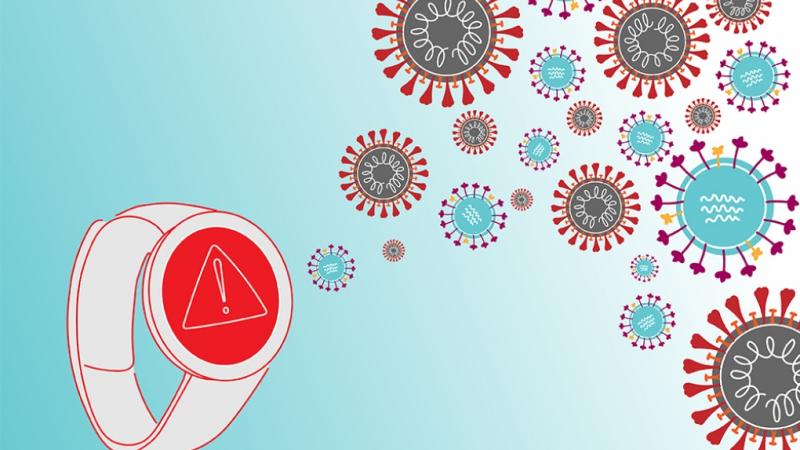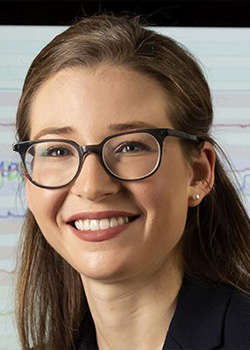
Early Detection of COVID-19: How Your Smartwatch Could Help
Duke researchers aim to detect coronavirus infections early in CovIdentify study
News of the first U.S. coronavirus case hit the American public on Tuesday, Jan. 21. For Jessilyn Dunn, PhD, assistant professor in the Departments of Biomedical Engineering and Biostatistics and Bioinformatics at Duke University and director of the Duke BIG IDEAs Lab, the infection in Washington State was a cue to launch a new study—CovIdentify.
Building on research she’d done at Stanford University in which she worked with wearable devices to detect Lyme disease, influenza, and other diseases which cause an inflammatory response, Dunn opened the study in early April, partnering with Duke colleagues Geoffrey Ginsburg, MD, PhD, Ryan Shaw, PhD and Chris Woods, MD, MPH.
For the study, the researchers are collecting physiological data from smartwatch and smartphone users and analyzing it to determine whether it can be used to indicate if the user is infected with COVID-19 and how severe that infection will likely become. The data is collected directly from the smartwatch or fitness tracker, called a “wearable,” as well as through daily online surveys the user must complete through an app on their smartphone.

The team began recruiting participants through the CovIdentify website and has enlisted over 5,500 as of August 2020. Participants in the study fill out a brief survey daily and can contribute health data, such as heart rate and activity monitoring, from their wearables. Most participants provide their own wearables, but the study offers discounts available with Garmin and Fitbit and has provided wearables to some of the participants.
Behind the scenes, the CovIdentify team works constantly to securely pull the data from the wearables and use disease-detecting algorithms to better recognize COVID-19 from the data collected. The researchers want to understand how the virus works. At the same time, they are developing new apps and striving to expand the reach of their study.
Dunn said that in previous research studies looking at the flu and Lyme Disease, “with our algorithms that we developed, we could actually tell that people were sick usually between 72 to 48 hours before they reported feeling sick. There were some obvious signs on their smartwatches,” such as elevated heart rate.
How well these algorithms will translate to detecting COVID-19—a fairly novel and poorly understood disease—is yet to be determined. But Brinnae Bent, a doctoral candidate in biomedical engineering working on the CovIdentify team, said monitoring people’s health with wearables will lead towards a better understanding of the mechanisms of the disease. Data collected varies from device to device, but sensors in wearables can record skin temperature, heart rate, motion, sleep and more.

“If we can understand which sensors might contribute more to telling us whether someone is going to have minor symptoms versus a more adverse reaction, we can start to discover a lot more about the intricacies of the disease, which are still unknown,” Bent said.
The team’s goal is to enlist 25,000 people in the first recruitment round. Ultimately Dunn hopes to gather data from hundreds of thousands of people. However, there are challenges of recruiting a diverse study population that include socioeconomics and language barriers.
A 2019 Pew Research Center Study found that around 31 percent of Americans living in households earning at least $75,000 a year regularly wore fitness trackers, whereas only twelve percent of Americans with household income below $30,000 did. Lately, Dunn spends her time racing to secure funding to address this socioeconomic skew.
"We're trying very hard find funding so that we are able to provide devices for those participants from underserved communities," Dunn said. Freshly-awarded grants from the North Carolina Biotechnology Center and Duke Bass Connections will allow the research team to purchase more devices to distribute to these populations.
Funding has allowed the researchers to provide over 170 wearables to study participants. “We're working hard to include those most at risk of COVID-19. We are in talks to distribute wearables to frontline workers at assisted living and skilled nursing facilities, to the Latinx community, and also to African American communities,” Shaw said.
In an attempt to recruit more racially and ethnically diverse research participants, Shaw said the CovIdentify team has also launched their study in Spanish to better reach North Carolina’s Latinx population. As of early August, the NC Department of Health and Human Services reported that Hispanics or Latinos account for 41 percent of coronavirus cases in the state for which ethnicity is known—that’s over 34,000 cases in the Latinx community. The 2019 census registered only 9.6 percent of North Carolina’s total population as Hispanic.

Introducing people to the benefits of digital health through wearables could also have a longer term positive effect beyond the coronavirus pandemic in terms of helping doctors and patients better monitor overall health, said Ginsburg. Wearables take hundreds of thousands of measurements per day, whereas a doctor might take a patient’s pulse a few times a year. Constant monitoring is the basis of precision medicine, he said.
“Up until the last five or six years, I would say that medicine has been practiced by people coming to the hospital and getting data at one point in time, and then they go away and you don't hear from them until they come back.,” said Ginsburg. “Now we have an opportunity in medicine to effectively get data all the time on our patients, to the extent that they're willing to share it.”
“It’s really important for us not to move too quickly and not move without some ethical frameworks,” he added.
Dunn was careful to emphasize that CovIdentify is not a contact tracing study. Participants can provide their zip code and address in the survey, but that’s optional, and the researchers won’t collect any other location information. They store participant data securely on Duke-approved servers.
Because of the speed at which the project was launched, CovIdentify leaders fully expect the project to evolve over time. They have accomplished in four months what normally would have taken at least a year.
“Generally we don't build the study as it's launched,” said Shaw. “We had to ramp up ASAP and we've been building out this project as the pandemic unfolds and as we learn more about COVID-19.”

Just weeks ago, CovIdentify's platform was maxed out at thousands of participants. Bent said the costs of storing health data are extremely high. But now a Microsoft AI for Health $90,000 grant will help them pay for additional space and resources to store the data of the hundreds of thousands of participants they are hoping for. They will be able to scale nearly infinitely.
“The success will be really dependent on the outreach,” Ginsburg said.
Although CovIdentify hopes to reach far beyond Duke’s walls, Shaw said their team realizes the potential for use of their wearable technology within Duke. They are looking for partnerships with other coronavirus tracking efforts at Duke to put wearables to use for students and patients close to home. Dunn said she hopes to continue the study for years to come and through multiple flu seasons, expanding to detect other infectious diseases in the future.
Lead graphic and text provided by Lillian Clark. Lillian Clark is a Statistics major at Duke and interested in all kinds of media, but particularly science journalism.
